#Sophia Charlotte of Mecklenburg-Strelitz
Explore tagged Tumblr posts
Text

Sophia Charlotte of Mecklenburg-Strelitz, wife of King George III, was indeed the first black queen of England. Born in 1744 in Germany, she became queen consort in 1761 when she married George III. Though there has been debate about her exact racial heritage, some historians believe she had African ancestry through a branch of the Portuguese royal family. Her lineage has been traced back to a 13th-century Portuguese noblewoman, Margarita de Castro e Sousa, who is believed to have been of African descent.
Sophia Charlotte was known for her intelligence, grace, and support for the arts. She was a patron of many musicians, writers, and intellectuals of her time. Her reign coincided with the height of the Enlightenment period, and she was known for her interest in philosophy and science.
Several books explore her life and legacy, delving into her role as queen consort and her impact on British society. One notable example is "Queen Charlotte: A Biography" by Olwen Hedley, which provides a comprehensive look at her life, from her upbringing in Germany to her years as queen consort. Another book worth mentioning is "Black Tudors: The Untold Story" by Miranda Kaufmann, which examines the presence of people of African descent in Tudor England and provides context for Sophia Charlotte's place in history.
Sophia Charlotte's story is a fascinating one, highlighting the diverse and complex history of the British monarchy. While her racial heritage has sometimes been overlooked or downplayed, her reign as queen consort left a lasting impact on British society and culture.
#Queen Charlotte#Sophia Charlotte of Mecklenburg-Strelitz#first black queen of England#read about her#grace#intelligence#beauty#knowledge is power#african american history#black history
14 notes
·
View notes
Photo
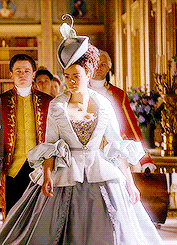






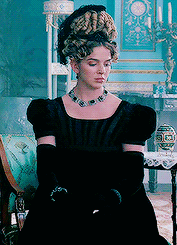

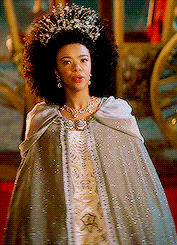
Costumes in Queen Charlotte: A Bridgerton Story ~ 1.01 Queen to Be
#Queen Charlotte: A Bridgerton Story#bridgertonedit#perioddramaedit#charlotte of mecklenburg strelitz#agatha danbury#augusta of saxe gotha#Princess Sophia#Princess Elizabeth#S1E01 Queen to Be#qcabs#costume edits#my edits
346 notes
·
View notes
Text

Charlotte Sophia of Mecklenburg-Strelitz
Artist: Workshop of Allan Ramsay (1713–1784)
Genre: Portrait
Date: Between 1761 and 1762
Medium: Oil on Canvas
Collection: National Portrait Gallery, London, England
Queen Charlotte; Princess Sophia Charlotte of Mecklenburg-Strelitz, 1744 - 1818. Queen of George III
Charlotte married George, Prince of Wales, in September 1761. A fortnight later they were crowned at Westminster Abbey and their coronation portraits commissioned from Ramsay, who had recently succeeded John Shackleton as Principle Painter in Ordinary. Charlotte is seen in a similar setting to her husband, with classical columns and rich drapery. In coronation robes of gold and ermine to match George, she gestures towards the crown. This version is by Ramsay’s studio – the replication of state portraits for heads of state, colonial governors, ambassadors etc, was a common occurrence during this time. There are subtle differences between the copies. Ramsay’s earliest version shows Charlotte wearing a pearl necklace, whereas later portraits, such as this, feature a gem encrusted necklace.
#portrait#charlotte sophia of mecklenburg-strelitz#queen of england#allan ramsey#18th century art#british royal family#classical columns#drapery#coronation robes#necklace#british royalty#british nobility
0 notes
Text
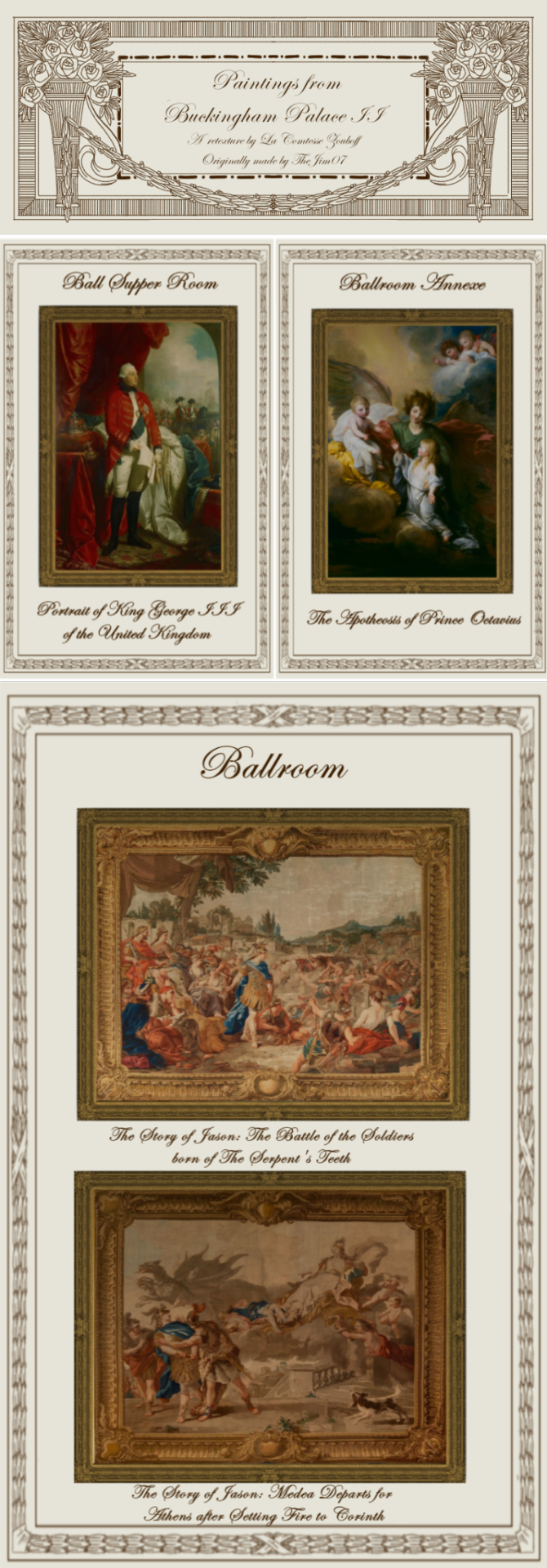
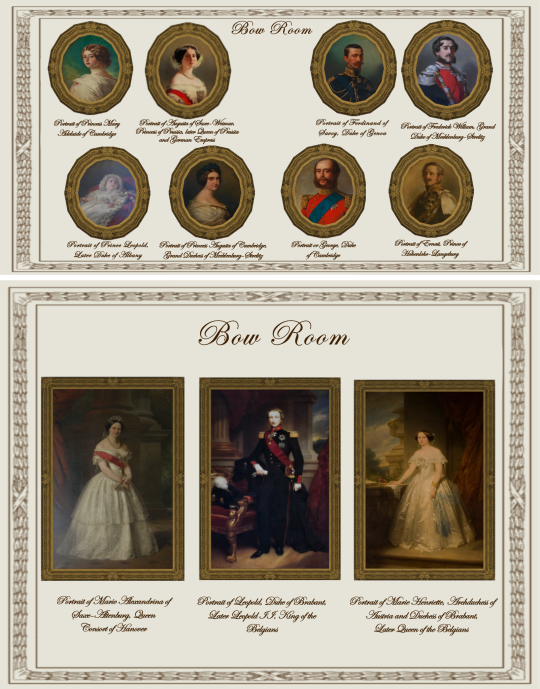
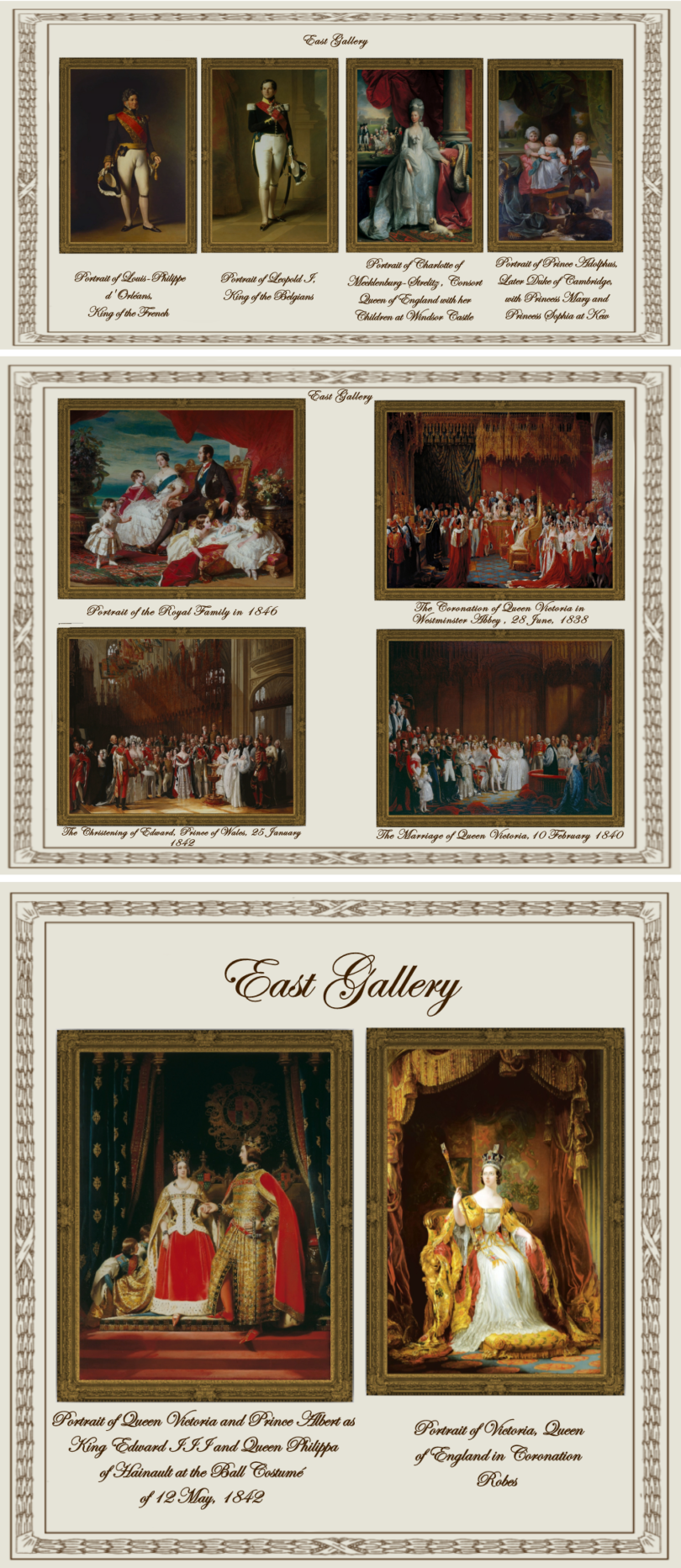
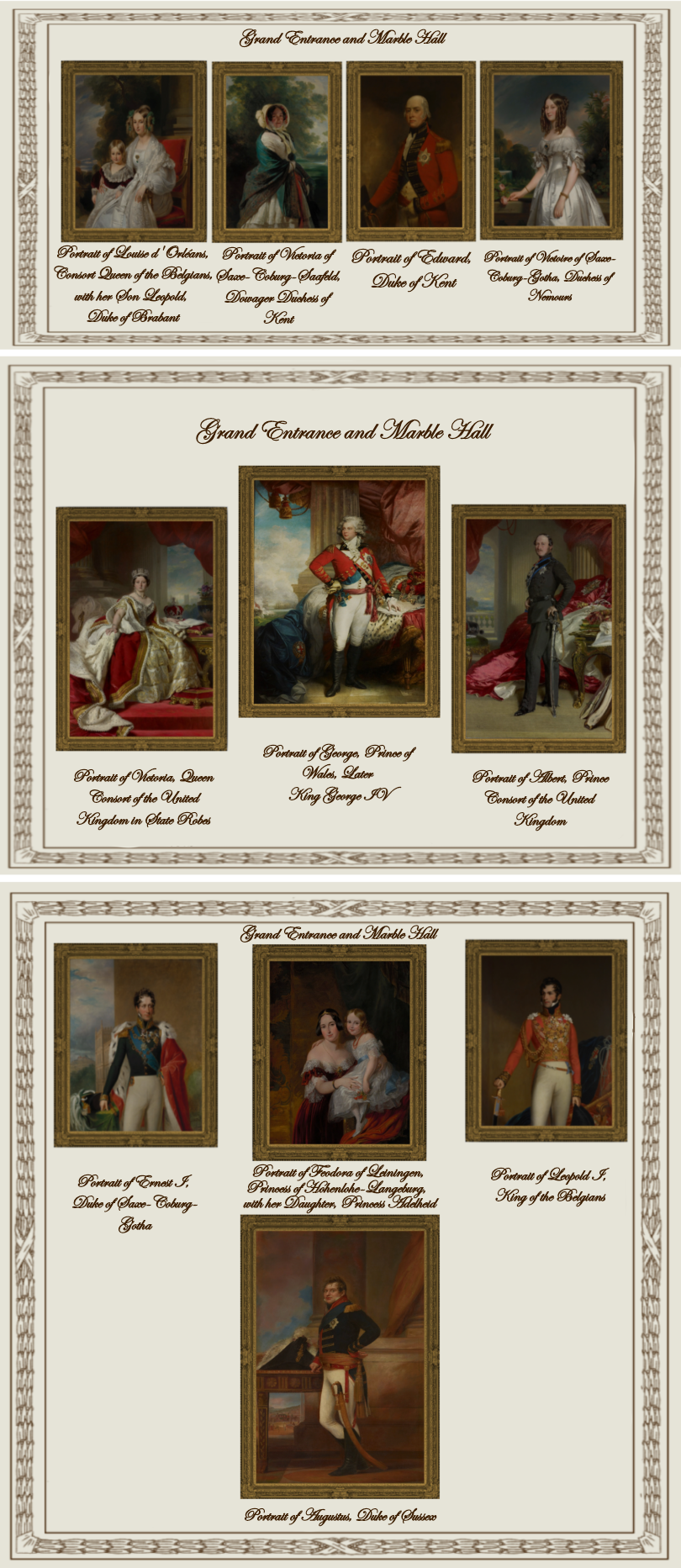

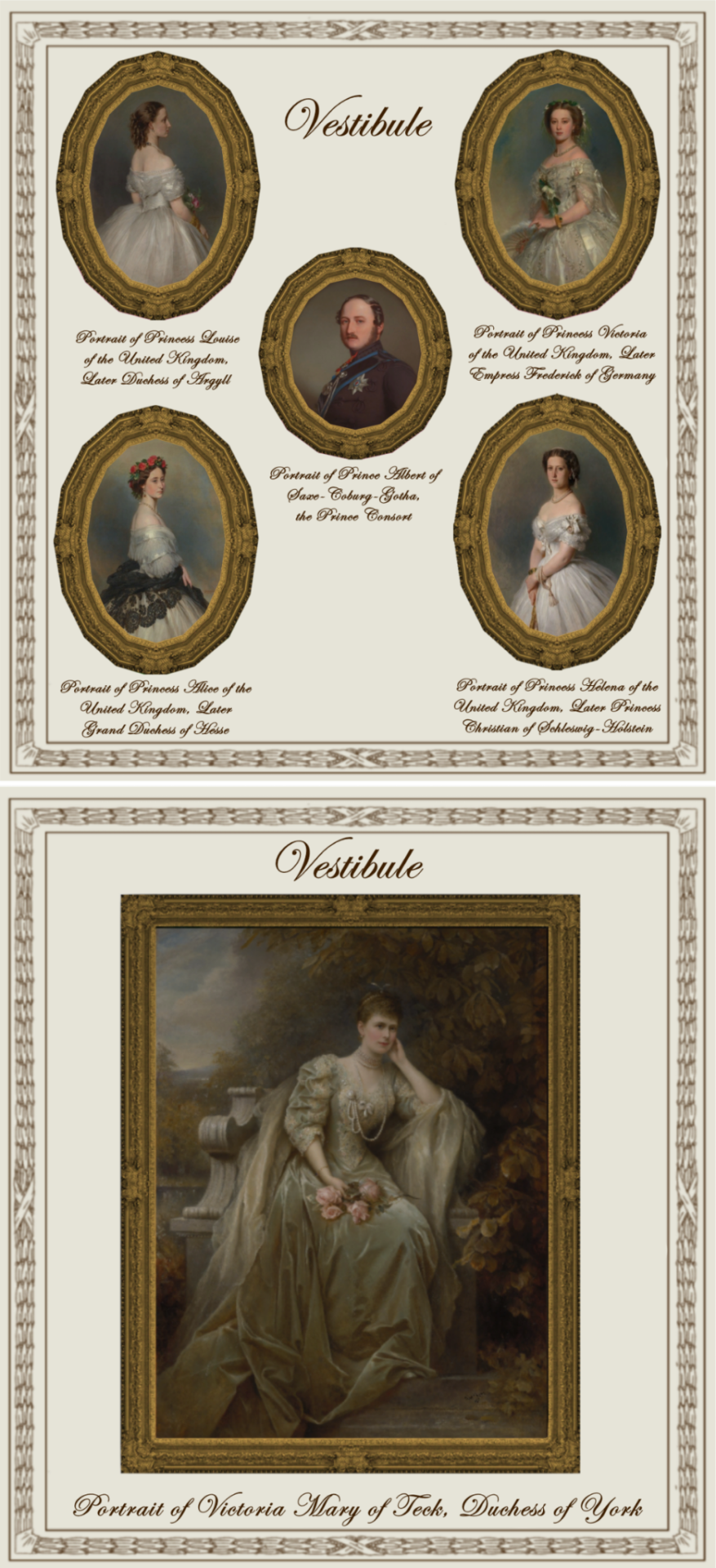
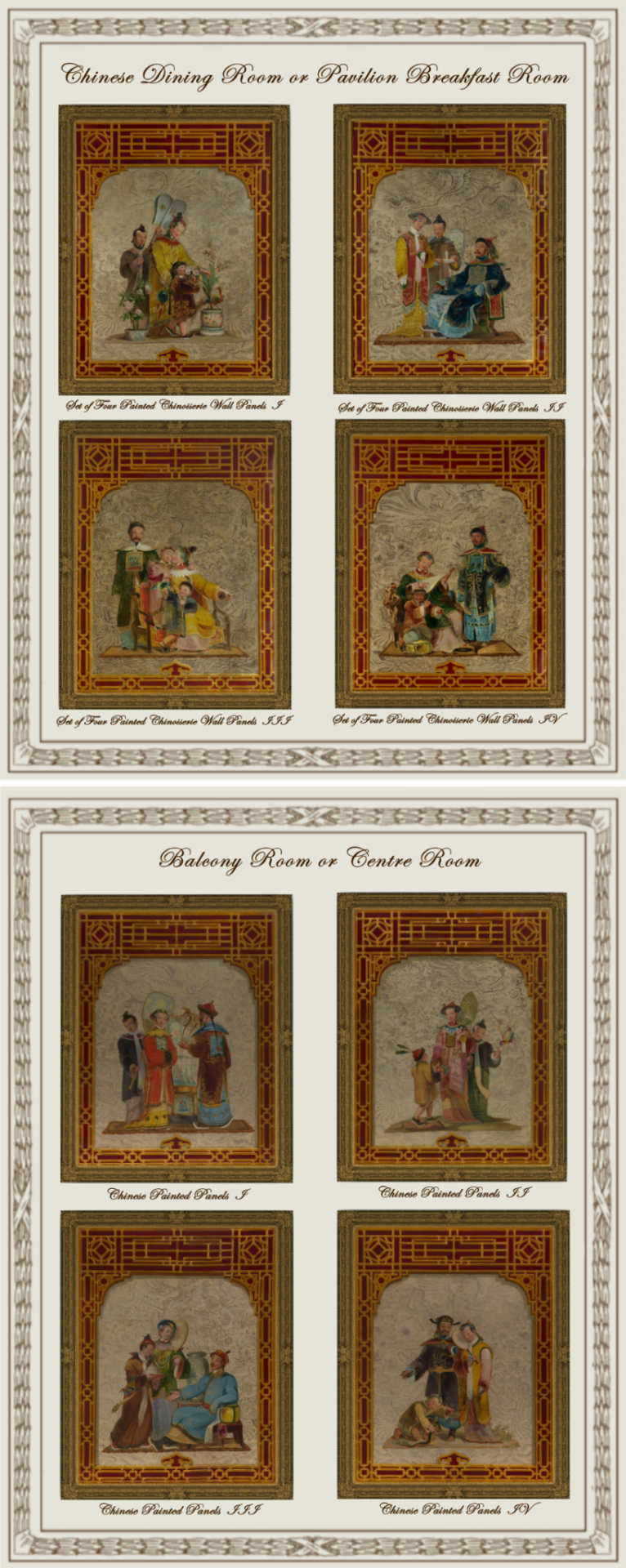

Paintings from Buckingham Palace: part II
A retexture by La Comtesse Zouboff — Original Mesh by @thejim07
Spread among 13 occupied and historic royal residences in the United Kingdom, the collection is owned by King Charles III and overseen by the Royal Collection Trust. The British monarch owns some of the collection in right of the Crown and some as a private individual. It is made up of over one million objects, including 7,000 paintings, over 150,000 works on paper, this including 30,000 watercolours and drawings, and about 450,000 photographs, as well as around 700,000 works of art, including tapestries, furniture, ceramics, textiles, carriages, weapons, armour, jewellery, clocks, musical instruments, tableware, plants, manuscripts, books, and sculptures.
Some of the buildings which house the collection, such as Hampton Court Palace, are open to the public and not lived in by the Royal Family, whilst others, such as Windsor Castle, Kensington Palace and the most remarkable of them, Buckingham Palace are both residences and open to the public.
About 3,000 objects are on loan to museums throughout the world, and many others are lent on a temporary basis to exhibitions.
-------------------------------------------------------
The second part includes paintings displayed in the Ball Supper Room, the Ballroom, the Ballroom Annexe, the Bow Room, the East Gallery, the Grand Entrance and Marble Hall, the Minister's Landing & Staircase, the Vestibule, the Chinese Dining Room and the Balcony Room.
This set contains 57 paintings and tapestries with the original frame swatches, fully recolourable. They are:
Ball Supper Room (BSR):
Portrait of King George III of the United Kingdom (Benjamin West)
Ballroom (BR):
The Story of Jason: The Battle of the Soldiers born of The Serpent's Teeth (the Gobelins)
The Story of Jason: Medea Departs for Athens after Setting Fire to Corinth (the Gobelins)
Ballroom Annexe (BAX):
The Apotheosis of Prince Octavius (Benjamin West)
Bow Room (BWR):
Portrait of Princess Mary Adelaide of Cambridge (William Corden the Younger)
Portrait of Princess Augusta of Cambridge, Grand Duchess of Mecklenburg-Strelitz (Alexander Melville)
Portrait or George, Duke of Cambridge (William Corden the Younger)
Portrait of Frederick William, Grand Duke of Mecklenburg-Strelitz (Franz Xaver Winterhalter)
Portrait of Augusta of Saxe-Weimar, Princess of Prussia, later Queen of Prussia and German Empress (Franz Xaver Winterhalter)
Portrait of Prince Leopold, Later Duke of Albany (Franz Xaver Winterhalter)
Portrait of Ernest, Prince of Hohenlohe-Langeburg (Franz Xaver Winterhalter)
Portrait of Ferdinand of Savoy, Duke of Genoa (Eliseo Sala)
Portrait of Marie Alexandrina of Saxe-Altenburg, Queen Consort of Hanover (Carl Ferdinand Sohn)
Portrait of Leopold, Duke of Brabant, Later Leopold II, King of the Belgians (Nicaise de Keyser)
Portrait of Marie Henriette, Archduchess of Austria and Duchess of Brabant, Later Queen of the Belgians (Nicaise de Keyser)
East Gallery (EG):
Portrait of Leopold I, King of the Belgians (Franz Xaver Winterhalter)
Portrait of Victoria, Queen of England in Coronation Robes (Sir George Hayter)
Portrait of Louis-Philippe d'Orléans, King of the French (Franz Xaver Winterhalter)
Portrait of Charlotte of Mecklenburg-Strelitz, Consort Queen of England with her Children at Windsor Castle (Benjamin West)
Portrait of Prince Adolphus, later Duke of Cambridge, With Princess Mary and Princess Sophia at Kew (Benjamin West)
The Coronation of Queen Victoria in Westminster Abbey, 28 June, 1838. (Sir George Hayter)
The Christening of Edward, Prince of Wales 25 January, 1842 (Sir George Hayter)
The Marriage of Queen Victoria, 10 February, 1840 (Sir George Hayter)
Portrait of the Royal Family in 1846 (Franz Xaver Winterhalter)
Portrait of Queen Victoria and Prince Albert as King Edward III and Queen Philippa of Hainault at the Ball Costumé of 12 May, 1842 (Sir Edwin Landseer)
Grand Entrance and Marble Hall (GEMH):
Portrait of Edward, Duke of Kent (John Hoppner)
Portrait of Ernest I, Duke of Saxe-Coburg-Gotha (George Dawe)
Portrait of Victoria of Saxe-Coburg-Saafeld, Dowager Duchess of Kent (Franz Xaver Winterhalter)
Portrait of Albert, Prince Consort of the United Kingdom (Franz Xaver Winterhalter)
Portrait of Victoria, Queen Consort of the United Kingdom in State Robes (Franz Xaver Winterhalter)
Portrait of Louise d'Orléans, Consort Queen of the Belgians, with her Son Leopold, Duke of Brabant (Franz Xaver Winterhalter)
Portrait of Feodora of Leiningen, Princess of Hohenlohe-Langeburg, with her Daughter, Princess Adelheid (Sir George Hayter)
Portrait of George, Prince of Wales, Later King George IV (Mather Byles Brown)
Portrait of Victoire of Saxe-Coburg-Gotha, Duchess of Nemours (Franz Xaver Winterhalter)
Portrait of Augustus, Duke of Sussex (Domenico Pellegrini)
Portrait of Leopold I, King of the Belgians (William Corden the Younger)
Minister's Landing and Staircase (MLS):
Portrait of George, Prince of Wales in Garther Robes (John Hoppner)
The Loves of the Gods: The Rape of Europa (the Gobelins)
The Loves of the Gods: The Rape of Proserpine (The Gobelins)
Vestibule (VL):
Portrait of Prince Albert of Saxe-Coburg-Gotha, the Prince Consort (Unknown Artist from the German School)
Portrait of Princess Alice of the United Kingdom, Later Grand Duchess of Hesse (Franz Xaver Winterhalter)
Portrait of Princess Helena of the United Kingdom, Later Princess Christian of Schleswig-Holstein (Franz Xaver Winterhalter)
Portrait of Princess Louise of the United Kingdom, Later Duchess of Argyll (Franz Xaver Winterhalter)
Portrait of Princess Victoria of the United Kingdom, Later Empress Frederick of Germany (Franz Xaver Winterhalter)
Portrait of Victoria Mary of Teck, Duchess of York (Edward Hughes)
Chinese Dining Room or Pavilion Breakfast Room(CDR):
Set of Four Painted Chinoiserie Wall panels I (Robert Jones)
Set of Four Painted Chinoiserie Wall panels II (Robert Jones)
Set of Four Painted Chinoiserie Wall panels III (Robert Jones)
Set of Four Painted Chinoiserie Wall panels IV (Robert Jones)
Balcony Room or Centre Room (BR):
Chinoiserie Painted Panel I (Robert Jones)
Chinoiserie Painted Panel II (Robert Jones)
Chinoiserie Painted Panel III (Robert Jones)
Chinoiserie Painted Panel IV (Robert Jones)
EXTRAS! (E):
I decided to add the rest of the tapestries from the story of Jason (wich hangs in the Grand Reception Room at Windsor Castle) and (with Jim's permission) added the original mesh for paintings number 2,3,4 & 5 from the Vestibule (seen here and here) wich was never published. These items are:
The Story of Jason: Jason Pledges his Faith to Medea (the Gobelins)
The Story of Jason: Jason Marries Glauce, Daughter of Creon, King of Thebes (the Gobelins)
The Story of Jason: The Capture of the Golden Fleece (the Gobelins)
The Story of Jason: The Poisoning of Glauce and Creon by Medea's Magic Robe (the Gobelins)
Sea Melodies (Herbert James Draper) (made by TheJim07)
-------------------------------------------------------
Found under decor > paintings for:
500§ (BWR: 1,2,3,4,5,6, & 8 |VL: 1)
570§ (VL: 2,3,4 & 5 |E: 5)
1850§ (GEMH: 1 & 3)
2090§ (GEMH: 2,6,7, 9 & 11)
3560§ (GEMH: 4,5 & 10 |BSR: 1 |EG: 1,2,3,4 & 5 |MLS: 1 |BAX: 1)
3900§ (CDR: 1,2,3 & 4 |BR: 1,2,3 & 4 |EG: 10 |VL: 6 |GEMH: 8)
4470§ (MLS: 2 |E: 1)
6520§ (BR 1 & 2| MLS: 3 |EG: 6,7,8 & 9 |BR: 1 & 2 |E: 2,3 & 4)
Retextured from:
"Saint Mary Magdalene" (BWR: 1,2,3,4,5,6, & 8 |VL: 1) found here.
"Sea Melodies" (VL: 2,3,4 & 5 |E: 5)
"The virgin of the Rosary" (GEMH: 1 & 3) found here.
"Length Portrait of Mrs.D" (GEMH: 4,5 & 10 |BSR: 1 |EG: 1,2,3,4 & 5 |MLS: 1 |BAX: 1) found here
"Portrait of Maria Theresa of Austria and her Son, le Grand Dauphin" (CDR: 1,2,3 & 4 |BR: 1,2,3 & 4 |EG: 10 |VL: 6 |GEMH: 8) found here
"Sacrifice to Jupiter" (MLS: 2 |E: 1) found here
"Vulcan's Forge" (BR 1 & 2| MLS: 3 |EG: 6,7,8 & 9 |BR: 1 & 2 |E: 2,3 & 4) found here
(you can just search for "Buckingham Palace" using the catalog search mod to find the entire set much easier!)
Disclaimer!
Some paintings in the previews look blurry but in the game they're very high definition, it's just because I had to add multiple preview pictures in one picture to be able to upload them all! Also sizes shown in previews are not accurate to the objects' actual sizes in most cases.
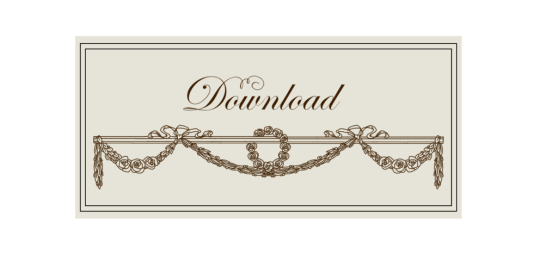
Drive
(Sims3pack | Package)
(Useful tags below)
@joojconverts @ts3history @ts3historicalccfinds @deniisu-sims @katsujiiccfinds @gifappels-stuff
-------------------------------------------------------
#the sims 3#ts3#sims 3#s3cc#sims 3 cc#sims 3 download#sims 3 decor#edwardian#victorian#regency#georgian#buckingham#buckingham palace#wall decor#sims 3 free cc#large pack#this was exhausting
70 notes
·
View notes
Text

Queen Charlotte (of Mecklenburg-Strelitz) (1744-1818)
Artist: Studio of Allan Ramsay (Scottish, 1713-1784)
Date: 1761
Medium: Oil on canvas
Collection: Royal Collection Trust, United Kingdom
Charlotte of Mecklenburg-Strelitz
Charlotte of Mecklenburg-Strelitz (Sophia Charlotte; 19 May 1744 – 17 November 1818) was Queen of Great Britain and Ireland as the wife of King George III from their marriage on 8 September 1761 until her death in 1818. The Acts of Union 1800 unified Great Britain and Ireland into the United Kingdom of Great Britain and Ireland. As George's wife, she was also Electress of Hanover until becoming Queen of Hanover on 12 October 1814. Charlotte was Britain's longest-serving queen consort, serving for 57 years and 70 days.
Charlotte was born into the ruling family of Mecklenburg-Strelitz, a duchy in northern Germany. In 1760, the young and unmarried George III inherited the British throne. As Charlotte was a minor German princess with no interest in politics, the King considered her a suitable consort, and they married in 1761. The marriage lasted 57 years and produced 15 children, 13 of whom survived to adulthood. They included two future British monarchs, George IV and William IV; as well as Charlotte, Princess Royal, who became Queen of Württemberg; and Prince Ernest Augustus, who became King of Hanover.
Charlotte was a patron of the arts and an amateur botanist who helped expand Kew Gardens. She introduced the Christmas tree to Britain, decorating one for a Christmas party for children of Windsor in 1800. She was distressed by her husband's bouts of physical and mental illness, which became permanent in later life. She maintained a close relationship with Queen Marie Antoinette of France, and the French Revolution is likely to have enhanced the emotional strain felt by Charlotte. Her eldest son, George, was appointed prince regent in 1811 due to the increasing severity of the King's illness. Charlotte died in November 1818, with her son George at her side. George III died a little over a year later, probably unaware of his wife's death.
#portrait#female#standing#full length#queen charlotte#british queen#british history#royal gown#interior#cape#table#crown#chair#pillar#allan ramsay#scottish painter#british monarchy#british royal family#painting#oil on canvas#fine art#18th century painting#scottish art#artwork#european art#royal collection trust
11 notes
·
View notes
Text

Charlotte Sophia of Mecklenburg-Strelitz painted by Allan Ramsay (1713 - 1784)
41 notes
·
View notes
Note
Friendly reminder to everyone that the real Queen Charlotte died in Nov. 1818. I was about to say that unless Shonda & Shondaland want to piss off historians, QC should die soon, or at the latest in between seasons 4 & 5 but, who am I kidding 😂 they've already pissed off almost half of the historian sphere & for various different reasons 😂 (one's topic of outrage depends on which area of expertise one has, the only one to beat Bridgerton in historian rage is The Crown)
P.S. How did I miss that her name is actually Sophia Charlotte of Mecklenburg-Strelitz? I knew the Mecklenburg part, I knew she had a daughter named Sophia but... SHE HERSELF IS NAMED SOPHIA
P.S.S. I hate to say it (because it goes against "my brand") but I'm slowly getting around to the idea that my girl Sophie is the illegitimate grandchild of QC...
See my theory is that they moved Polin's season in order to have Queen Charlotte present for the Whistledown story. While QC wasn't present in the books, in the show her main storyline has been her vested interest and obsession with Lady Whistledown and trying to figure out who she is. If the show had followed along the timeline set in the books then by 1824 when Polin get together and Whistledown is revealed QC (historically) would have been long dead and it would make her storylines in the first two seasons essentially null and void. There would be no pay-off to have her absent from a storyline she was involved in and so I personally think that's one of the main reasons Polin's season was moved forward. I also think that's why the Queen Charlotte spin-off was created and capitalised now while she's still present in the main Bridgerton series; to me these decisions were all made because of QC's real life death occurring mid-way through the show's timeline and they're going to adhere to that fact.
#asks#however if the show chooses to ignore history and keep her for the series run then this has been a moot point lmao#bridgerton timeline#queen charlotte
11 notes
·
View notes
Text
Charlotte/George AU (drabble)
"I'm a lady in distress," she said sharply. Let shame be her weapon if there was nothing else left. "You refuse to help a lady in distress?"
His impressive eyebrows lifted slightly. "I refuse to help a lady in distress climb over a garden wall... to be caught by the guards waiting on the other side less than five paces away."
Her heart jumped at that news, and his expressive mouth twisted in a tiny smirk.
"Especially," he continued smoothly, "when I have a perfectly good carriage that can spirit her away long before people realize you are no longer on the palace grounds."
She blinked. What? "You wish to assist me?" A horse and carriage was a leap from the simple request to boost her over the wall.
"You said it yourself... you're a lady in distress. A foreign lady in distress, who if she managed to escape from these grounds, will surely be discovered the moment she opened her mouth in the middle of London."
Charlotte drew herself up in outrage. "I speak perfect English. My accent is barely even..."
"That's the problem," he said with a laugh. "Your English is too perfect. You won't be able to hide who you are... Princess Sophia Charlotte of Mecklenburg-Strelitz."
She stiffened. All this while, she had assumed he didn't know who she was. She poised, ready to flee. And she must have given herself away because he reached out and held her.
It wasn't the firm, cruel grip she half-expected, but a gentle touch on her hand, like the way you would touch an unfamiliar Dormer you weren't sure would bite you or lick your hand.
"Never fear, your Highness. I will keep you safe."
She didn't know him. For all she knew, he would drag her back kicking and screaming to the Church, and she would have to go through with the wedding to that beast of a King.
His hand on hers tightened, but it wasn't so much a touch to restrain, but to reassure. "Trust me," he said quietly.
For the first time during this strange encounter, she really looked at the man she was talking to. He wasn't merely, as she had first thought, fair of face. He was almost extraordinary good-looking, with sharp angles in his face that managed to be both attractive and... severe. His eyes were dark, deep-set and full of secrets. But despite that, there was a sense she felt looking at him... Not trust. But... inevitability. Like she already knew she would go with him, before she made the decision to do so.
Besides, she told herself later, I didn't have much of a choice.
"OK. Take me to this carriage, and away from here at once."
He smiled, and the shadows seemed to fly out of his face. He dipped his head in a bow. Holding her hand, he led her out of the garden.
10 notes
·
View notes
Text
Britain’s First Black Queen? The Real Story of Queen Charlotte
Historians still debate whether she was really Britain’s First Black Queen. But a new Netflix spin-off of the popular 'Bridgerton' makes clear that interest in her life is stronger than ever.
— By Erin Blakemore | May 10, 2023
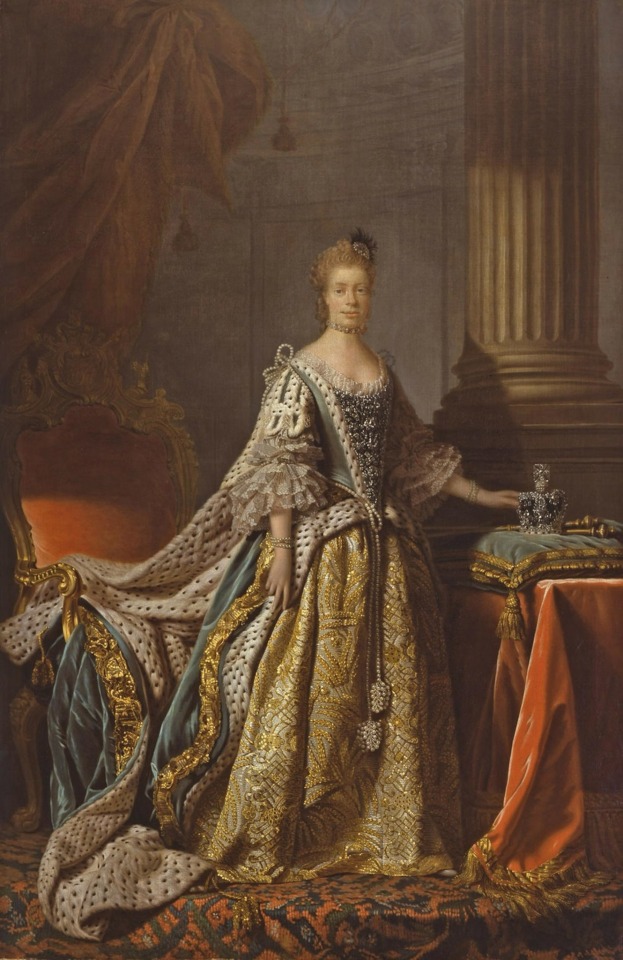
Scottish Painter Allan Ramsay's Portrait of Queen Charlotte in her Coronation Robes has inspired debate over whether she was Britain's First Black Queen—a question that persists today, centuries after she ruled over Great Britain and Ireland. Image Via Art Collection /Alamy Stock Photo
When 17-year-old Sophia Charlotte of Mecklenburg-Strelitz caught her first glimpse of the London palace that was to be her home in 1761, she turned pale. She was set to become Queen of Great Britain and Ireland within hours, but she had never set foot in England or met her husband-to-be.
What happened next is the stuff of royal history—and the subject of Queen Charlotte: A Bridgerton Story. The new Netflix limited series fictionalizes the life of the timid German girl destined to rule England—and who is rumored to have been its first Black queen. But who was the real Queen Charlotte?
How Charlotte Became Queen of Great Britain

Just beneath this Oval Portrait of Charlotte of Mecklenburg-Strelitz, you'll see the Initials of the Royal Couple: G for George III and C for Charlotte. Despite the Queen's initial timidity, historians say that the Monarch by all accounts had a Happy Marriage. Image By Johann Esaias Nilson Via BTEU/RKMLGE/Almay Stock Photo
Born in 1744 in Mecklenburg-Strelitz, a duchy in what is now Northern Germany, the princess had an unremarkable childhood in what other members of the European aristocracy considered to be a mediocre and provincial dukedom. But this would work in the young woman’s favor when a far-off prince became king.
In 1760, George III’s grandfather died, making him King of England—and making his unmarried status a matter of national alarm. George needed a wife, and he needed one fast, his advisers decided—and they mounted a desperate search for a Protestant princess to share his life and sire an heir.
Charlotte was unknown and thought to have no political connections or aims. This was seen as a plus by George’s political advisers, who wanted British interests to prevail after the king’s marriage. And so, though George had never met Charlotte, in 1761 an emissary proposed marriage on his behalf. Charlotte accepted, and the arranged marriage took place just six hours after the young princess arrived in England.
Though she spoke no English and had never met her husband before her wedding day, Charlotte was now Queen of Great Britain and Ireland. Everyone wanted to greet the new king and queen: At their coronation, so many well-wishers crowded them that it took two hours to for their procession to make it from the street into Westminster Abbey. Soon, Charlotte had her first child, a daughter. She would go on to bear 15 children during her long marriage.
Were Queen Charlotte and King George in Love?
By all reports, the king and queen had an unusually happy marriage, and George III was a devoted father and husband. But court life was difficult for Charlotte, who clashed with her mother-in-law over the formal rules of the British aristocracy and found the expectation to bear plenty of heirs exhausting. By the time she had borne 14 of her 15 children, she wrote that “I don’t think a prisoner could wish more ardently for his liberty than I wish to be rid of my burden.”
Though Charlotte struggled with the boredom and confinement of court life, she found her own ways to deal with the crushing expectations of her new role. The year after her marriage, George bought her a large country estate owned by the Dukes of Buckingham. Buckingham House, now known as Buckingham Palace, was called the “Queen’s House,” and there she lived in comfortable domesticity, reading, doing needlework, and playing the harpsichord.
She shared a love of botany and plants with her husband, who became known as “Farmer George” due to his agricultural interests.
The 'Madness' of King George
But the couple’s happiness did not last. In 1765, George experienced a bout of mental illness so serious that his ministers proposed having Charlotte temporarily take the throne while the king was incapacitated.
Though the king soon recovered, he experienced relapse after relapse, and eventually it became clear his mental illness would not pass. The king experienced mania, depression, hallucinations, and convulsions, and historians report that he attacked and even sexually assaulted members of his family.
These bouts of illness devastated the queen. “The queen is almost overpowered with some secret terror,” wrote Francis Burney, one of Charlotte’s attendants, in 1788. “I am affected beyond all expression in her presence, to see what struggles she makes to support serenity.” Over time, the bouts turned into lengthy episodes, and the king was isolated and even incarcerated.
Social stigma and lack of understanding of mental illness meant it was nearly impossible to help the “mad” king or gain the kind of support now regarded as key for the caretakers and loved ones of people with mental illness.
Eventually, Charlotte’s son George (later George IV) took over the throne as regent. But her husband would remain ill for the rest of his life, and by 1789 the queen’s hair had “turned white under the stress of the King’s illness.” When Charlotte died in 1818, her husband was so ill he did not understand his wife was dead.
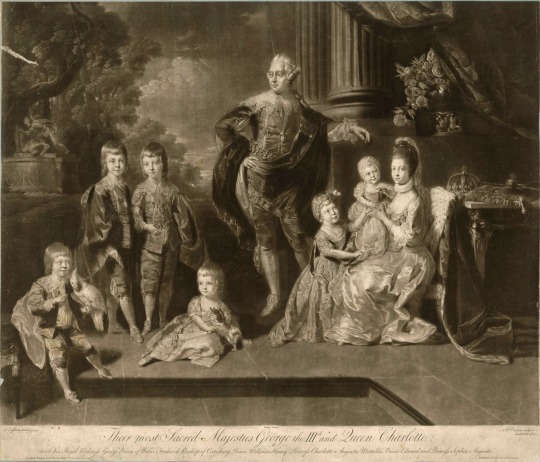
George III and Queen Charlotte Pose with their Children. The Queen gave birth to 15 children—a responsibility of her position that she found particularly exhausting. Image By Richard Earlom, Via National Museums in Berlin, Art Library/Anna Russ
Was Charlotte Teally Britain’s First Black Queen?
Today, Charlotte is remembered as a faithful wife and a tragic figure connected with the king’s mental illness. But some see her as noteworthy for another reason—they claim she was Great Britain’s First Black or Biracial Queen. For decades, historians have debated whether Charlotte’s Ancestral Ties to Portuguese Aristocracy Mean She had Brown Skin.
Those who believe she had Black ancestry point to portraits that show what they describe as “African” features and say other depictions of the time that show the queen as light-skinned would have been hiding her ancestry to conform with the era’s Eurocentric beauty ideals. But others say the queen’s ancestry was so distant it likely did not affect her looks, and argue that modern conceptions of race are what’s driving the belief that Charlotte was black.
Since it’s impossible to determine how Charlotte really looked in real life, the argument will likely never be settled. Nor will public interest in Charlotte’s life, as evidenced by the new Netflix limited-run series—which has gained fans, charmed reviewers, and drawn newfound attention to the tragic queen’s life. But as narrator Julie Andrews says in the show itself, “It is fiction inspired by fact.”
#Britain 🇬🇧#First Black Queen#Story#Queen Charlotte#History#Historians#Great Britain 🇬🇧 | Ireland 🇮🇪#Britain's First Black Queen Charlotte#King George#Ancestry#Ancestral#Portugal 🇵🇹#Portuguese 🇵🇹
2 notes
·
View notes
Text
The Pearl
book one

The beginning
Act One - The Beginning Third person
Fifty - Six Years Earlier
Essex , England The London Road 8th September 1761
Like all members go the German aristocracy , Princess Sophia Charlotte of Mecklenburg-Sterlitz, was in possession of a great many names. Sophia for maternal Grandmother, Sophia Albertine of erbach-erbach, a countess by birth and duchess by marriage. Charlotte for her farther, Charles Louis Fredrick of Mechlenburg-strelitz,who was born second son and had died before he could assume the position of head of the family. Then there were the many and sundry double-barrelled lands and properties that made up her heritage.She enjoyed all of her names, and she was proud of every last one , but the one she liked best was Lottie.Lottie . It was the simplest of the bunch but that wasn't why she liked it, you had to know her to call her Lottie .Adolphus was the one who'd coined the pet name Lottie. And that was the true reason it was her favourite name. It had been bestowed upon her by her favourite brother.
pardon , her former favourite brother
" You give the appearance of a statue ." Adolphus said, smiling as if she had not spent the last three weeks begging him not to marry her off to a stranger. Charlotte wanted to ignore him. She'd have liked nothing better than to never utter a word in his direction for the remainder of both of their lives, but even she recognised the futility of such stubbornness. And besides, they where in a carriage in the southeast of England, and they had a long ride both ahead and behind them .she was bored and furious, never a good combination.
" Statues are works of art," she said icily. " Art is beautiful ."
this made her brother smile, damn his eyes. " Art can be beautiful to gaze upon," he said with some amusement. " You, on the other hand, are ridiculous to the eye."
" Is there a point? " Charlotte bit off.He shrugged . " You have not moved in an inch in six hours."Oh. Oh. He should have not gone there. Charlotte levelled her dark eyes on his with ferocity that ought to have terrified him.
----------------------------------
Essex , England South-East London Greenwich Blackson House 8th September 1761
In one of the many room of the Blackson home sits a light brunette young women infant of a gold mirror as she is being smothered over by her lady maids all each to their own tasks.
" It ought to not be so bad my Lady " an older maiden speaks up with a motherly tone seeing the young Ladys frown. " why must I go?" she grumbles blankly in reply to the older women," it is out of respect from the Blackson family Mariah my dear" the older lady says softly with a hint of sternness that Mariah knows not to argue back against.
Four-teen years ago Mrs and Mr Blackson died in a carriage accident leaving their only daughter, Mariah age Five ,an orphan and to be brought up in the maids and staff hands to become the next leader of the Blackson house. It has been lonely on her own as she grew up with no one but staff members all around her, in result she slowly but surely built up these high walls guarding her soft, shattered beating heart that is slowly losing hope for her innocent broken soul.
Mariah stand infront of the golden floor length mirror looking back at her self not quite sure on who the person she is looking at. To others she looks beautiful,elagent with her white and baby blue dress with french trimming and white pearls a peal necklace and earrings the hair in a low bun with some lose braids and curls with a pearl and gold tiara headband white gloves ,white and gold heels , white umbrella with laze gold trimming and the Blackson initials
...but too her she doesn't recognise herself or the girl inside of her she's just lost or more like hiding.wever that will be only temporary or for good she will never know..snapped out of her thoughts by a hand on her shoulder , Mariah glances up to the older women with her eyes and gives a silently nod at the worried look casted her way.with one last glance to herself in the mirror she leaves the room heading down the hallways and grand stairs to the very carriage awaiting for her at the front door.
-------------------------------------
" I am wearing Lyonnaise silk. Encrusted with Indian sapphires. Withan overlay of two-hundred-year-old lace."
"And you look beautiful,"he said, he reached out to pat her knee, then hastily withdrew his hand when he caught her expression. Murderous
" Apparently too much movement could cause the sapphires to shred the lace." Charlotte growled. She literally growled." Do you want me to shred the lace? do you ?"she did not wait for him to answer. They both knew he was not meant to." If that were not enough," she continued, " the gown sits ontop a be-spoke underpinning made of whalebone."
" Whalebone ?"
" Yes, whalebone, brother. The bone of whales. Whales died so I could look like this."
At that, Adolphus laughed outright. " Lottie-"
" Don't ," Charlotte warned him " Don't you dare call me Lottie as if you care."
" Come, Liebchen, you know I care."
" Do I? Because it does not feel as if you care. It feels as if I have been trussed up like a prized sow and upon the alter as sacrafice."
" Charlotte-"
she bared her teeth." Shall u put an apple in my mouth?"
" Charlotte, stop. You were chosen by the King. This is a great honor."
" That." Charlotte spat. " that is why I am angry. The lies. You will not stop lying."she could not stand it, these endless lies. This was no honor, she wasn't sure what it was, but certainly not an honor.
King George III of Great Britain and Ireland had appeared out of no where( or rather, his people had; he had not deigned to make an appearance ) and inexplicably decided that she, Sophia Charlotte of Mecklenburg-Sterelitz, should be his next queen. Mecklenburg-Sterelitz.
---------------------------
Hello I hope you liked thus chapter.
Do not ask for updates or new chapters I will try and do it as much as i can.
do not be afraid to comment and leave your imput and what the name of the love intrest u want it to be wether its a OC or a character in Queen Charlotte but it will not be King George as he is my wife charlottes man no discussions. if u have seen any spelling mistakes or any ideas at all for plots and things u wanna see then go ahead and leave a comment.
1113 words
#1813-1827#bridgerton#colinbridgerton#courting#daphnebridgerton#engaland#kinggeorge#ladyagathadanbury#lordanthoneybridgerton#queencharlotte#simonbasset#thefeatheringtons#book one pearl series
0 notes
Photo










the granddaughters of george iii and charlotte of mecklenburg-strelitz
#history#historyedit#charlotte of wales#charlotte of mecklenburg strelitz#sophia fitzclarence#english history#british history#18th Century#19th Century#queen victoria#mary fitzclarence#elizabeth fitzclarence#augusta fitzclarence#amelia fitzclarence#augusta d'este#augusta of cambridge#mary of cambridge#20th Century#our edits#by julia
247 notes
·
View notes
Photo






~ 𝐻𝑎𝑛𝑜𝑣𝑒𝑟𝑖𝑎𝑛 𝐸𝑟𝑎 𝑐𝑜𝑛𝑠𝑜𝑟𝑡𝑠~
1. Sᴏᴘʜɪᴀ Dᴏʀᴏᴛʜᴇᴀ ᴏғ Cᴇʟʟᴇ﹐ Eʟᴇᴄᴛᴏʀᴀʟ Pʀɪɴᴄᴇss ᴏғ Hᴀɴɴᴏᴠᴇʀ. Mᴀʀʀɪᴇᴅ Gᴇᴏʀɢ Lᴜᴅᴡɪɢ ʙᴇғᴏʀᴇ ʜᴇ ʙᴇᴄᴀᴍᴇ Kɪɴɢ Gᴇᴏʀɢᴇ I ᴏғ Gʀᴇᴀᴛ Bʀɪᴛᴀɪɴ. Tʜᴇʏ ᴡᴇʀᴇ sᴇᴘᴀʀᴀᴛᴇᴅ ʙʏ ₁₆₉₄﹐ sᴏ sʜᴇ ᴡᴀs ɴᴏᴛ ᴀᴄᴋɴᴏᴡʟᴇᴅɢᴇᴅ ɴᴏʀ ᴄʀᴏᴡɴᴇᴅ ᴀs ʜɪs ϙᴜᴇᴇɴ ᴄᴏɴsᴏʀᴛ.
2. Cᴀʀᴏʟɪɴᴇ ᴏғ Aɴsʙᴀᴄʜ. Qᴜᴇᴇɴ ᴄᴏɴsᴏʀᴛ ᴛᴏ Kɪɴɢ Gᴇᴏʀɢᴇ II. Sʜᴇ ʀᴇᴘᴏʀᴛᴇᴅʟʏ ʜᴀᴅ ᴀ ᴛᴇʀʀɪʙʟᴇ ʀᴇʟᴀᴛɪᴏɴsʜɪᴘ ᴡɪᴛʜ ʜᴇʀ ᴏʟᴅᴇsᴛ sᴏɴ ᴀɴᴅ ʜᴇɪʀ﹐ Fʀɪᴇᴅʀɪᴄʜ Lᴜᴅᴡɪɢ ﹙Fʀᴇᴅᴇʀɪᴄᴋ Lᴏᴜɪs﹚﹐ ʙᴜᴛ ʜᴇʀ ᴅᴇᴇᴅs ᴄᴀɴɴᴏᴛ ʙᴇ ᴏᴠᴇʀsʜᴀᴅᴏᴡᴇᴅ ʙʏ ʜɪsᴛᴏʀʏ. Sʜᴇ ᴘᴏssᴇssᴇᴅ ϙᴜɪᴛᴇ ᴀ ᴡɪᴛ﹐ ᴇɴᴊᴏʏɪɴɢ ᴡɪᴛᴛʏ ᴄᴏɴᴠᴇʀsᴀᴛɪᴏɴs ᴀɴᴅ ᴡᴀs ᴀᴘᴘᴀʀᴇɴᴛʟʏ ғᴏɴᴅ ᴏғ Vᴏʟᴛᴀɪʀᴇ. Sʜᴇ ᴡᴀs ᴀʟsᴏ ᴀᴅᴍɪʀᴇᴅ ғᴏʀ ʜᴇʀ ʙᴇᴀᴜᴛʏ.
3. Cʜᴀʀʟᴏᴛᴛᴇ ᴏғ Mᴇᴄᴋʟᴇɴʙᴜʀɢ﹣Sᴛʀᴇʟɪᴛᴢ. Qᴜᴇᴇɴ ᴄᴏɴsᴏʀᴛ ᴛᴏ ᴛʜᴇ Bʀɪᴛɪsʜ Kɪɴɢ Gᴇᴏʀɢᴇ III. Tʜᴇ ʟᴏɴɢᴇsᴛ ᴄᴏɴsᴏʀᴛ ᴏғ ᴛʜᴇ Bʀɪᴛɪsʜ ɪsʟᴇs sᴏ ғᴀʀ ʀᴇᴄᴏʀᴅᴇᴅ. A ᴄᴜʀɪᴏsɪᴛʏ ғᴇᴡ ʀᴇɢᴀʀᴅ ʜᴇʀ ɪs ʜᴇʀ ғʀɪᴇɴᴅsʜɪᴘ ᴛᴏ Mᴀʀɪᴇ Aɴᴛᴏɪɴᴇᴛᴛᴇ﹐ Qᴜᴇᴇɴ ᴏғ Fʀᴀɴᴄᴇ﹐ ᴅᴇsᴘɪᴛᴇ ᴛʜᴇ ᴅɪғғᴇʀᴇɴᴄᴇ ɪɴ ᴛᴇᴍᴘᴇʀᴀᴍᴇɴᴛs. Cʜᴀʀʟᴏᴛᴛᴇ ᴇᴠᴇɴ ᴍᴀɴᴀɢᴇᴅ ᴛᴏ ᴀʀʀᴀɴɢᴇ ᴀᴘᴀʀᴛᴍᴇɴᴛs ғᴏʀ ʜᴇʀ ғᴇʟʟᴏᴡ ϙᴜᴇᴇɴ ɪɴ ᴡʜᴀᴛ sʜᴇ ᴇxᴘᴇᴄᴛᴇᴅ ᴀɴ ᴇsᴄᴀᴘᴇ ғʀᴏᴍ ᴛʜᴇ Fʀᴇɴᴄʜ ᴄᴏɴsᴏʀᴛ ᴅᴜʀɪɴɢ ᴛʜᴇ ʀᴇᴠᴏʟᴜᴛɪᴏɴ ɪɴ ᴛʜᴇ ᴄᴏɴᴛɪɴᴇɴᴛ﹐ ʙᴜᴛ ᴡʜᴇɴ ᴛʜɪs ɴᴇᴠᴇʀ ᴄᴀᴍᴇ ᴛᴏ ғʀᴜɪᴛɪᴛɪᴏɴ﹐ sʜᴇ ᴡᴀs ʀᴇᴘᴏʀᴛᴇᴅʟʏ ᴜᴘsᴇᴛ.
4. Cᴀʀᴏʟɪɴᴇ ᴏғ Bʀᴜɴsᴡɪᴄᴋ. Qᴜᴇᴇɴ ᴄᴏɴsᴏʀᴛ ᴛᴏ Kɪɴɢ Gᴇᴏʀɢᴇ IV﹐ ᴡɪᴛʜ ᴡʜᴏᴍ sʜᴇ ʜᴀᴅ ᴀ ᴠᴇʀʏ ᴜɴʜᴀᴘᴘʏ ᴍᴀʀʀɪᴀɢᴇ ᴛᴏ ᴛʜᴇ ᴘᴏɪɴᴛ ᴡʜᴇʀᴇ sʜᴇ ᴡᴀs ғᴏʀʙᴀᴅᴇ ᴛᴏ ᴘʀᴇsᴇɴᴛ ʜᴇʀsᴇʟғ ɪɴ ᴛʜᴇ ᴋɪɴɢ·s ᴄᴏʀᴏɴᴀᴛɪᴏɴ. Dᴇsᴘɪᴛᴇ ᴛʜᴇ ᴄᴏɴᴛʀᴏᴠᴇʀsɪᴀʟ ᴜɴɪᴏɴ﹐ ᴛʜᴇʏ ᴍᴀɴᴀɢᴇᴅ ᴛᴏ ᴘʀᴏᴅᴜᴄᴇ ᴏɴᴇ ᴄʜɪʟᴅ﹐ Pʀɪɴᴄᴇss Cʜᴀʀʟᴏᴛᴛᴇ Aᴜɢᴜsᴛᴀ ᴏғ Wᴀʟᴇs. Cᴀʀᴏʟɪɴᴇ﹐ ᴀs Qᴜᴇᴇɴ﹐ ᴡᴀs ᴀʟsᴏ ᴘᴏᴘᴜʟᴀʀ ᴀᴍᴏɴɢsᴛ ᴛʜᴇ sᴜʙᴊᴇᴄᴛs. Aᴘᴘᴀʀᴇɴᴛʟʏ sʜᴇ sᴀɪᴅ sᴏ ᴏɴ ₁₈₂₀﹕ ··Aʟʟ ᴄʟᴀssᴇs ᴡɪʟʟ ᴇᴠᴇʀ ғɪɴᴅ ɪɴ ᴍᴇ ᴀ sɪɴᴄᴇʀᴇ ғʀɪᴇɴᴅ ᴛᴏ ᴛʜᴇɪʀ ʟɪʙᴇʀᴛɪᴇs﹐ ᴀɴᴅ ᴀ ᴢᴇᴀʟᴏᴜs ᴀᴅᴠᴏᴄᴀᴛᴇ ᴏғ ᴛʜᴇɪʀ ʀɪɢʜᴛs.··
5. Aᴅᴇʟᴀɪᴅᴇ ᴏғ Sᴀxᴇ﹣Mᴇɪɴɪɴɢᴇɴ. Qᴜᴇᴇɴ ᴄᴏɴsᴏʀᴛ ᴛᴏ Kɪɴɢ Wɪʟʟɪᴀᴍ IV. Bᴇʟᴏᴠᴇᴅ ϙᴜᴇᴇɴ ʙʏ ᴛʜᴇ ᴄᴏᴍᴍᴏɴ ғᴏʟᴋ﹐ ᴋɴᴏᴡɴ ғᴏʀ ʜᴇʀ ᴘɪᴇᴛʏ﹐ ᴍᴏᴅᴇsᴛʏ ᴀɴᴅ ɢᴇɴᴛʟᴇ ʜᴇᴀʀᴛ. Hᴀᴅ ɢᴏᴏᴅ ʀᴇʟᴀᴛɪᴏɴs ᴡɪᴛʜ ʜᴇʀ ɴɪᴇᴄᴇ﹐ Vɪᴄᴛᴏʀɪᴀ﹐ ɪɴ sᴘɪᴛᴇ ᴏғ ᴛʜᴇ ᴇsᴛʀᴀɴɢᴇᴍᴇɴᴛ ʙᴇᴛᴡᴇɴ ʜᴇʀ ʜᴜsʙᴀɴᴅ ᴀɴᴅ Vɪᴄᴛᴏʀɪᴀ·s ᴍᴏᴛʜᴇʀ. Tʜᴇ ᴄᴀᴘɪᴛᴀʟ ᴏғ ᴛʜᴇ Sᴏᴜᴛʜ Aᴜsᴛʀᴀʟɪᴀ ʀᴇᴄᴇɪᴠᴇᴅ ɪᴛ·s ɴᴀᴍᴇ ᴀғᴛᴇʀ ᴛʜɪs ϙᴜᴇᴇɴ.
6. Aʟʙᴇʀᴛ ᴏғ Sᴀxᴇ﹣Cᴏʙᴜʀɢ ᴀɴᴅ Gᴏᴛʜᴀ. Pʀɪɴᴄᴇ ᴄᴏɴsᴏʀᴛ ᴛᴏ Qᴜᴇᴇɴ Vɪᴄᴛᴏʀɪᴀ. Tʜᴇ ʙᴇʟᴏᴠᴇᴅ ʜᴜsʙᴀɴᴅ ᴏғ ᴛʜᴇ ϙᴜᴇᴇɴ ᴡʜᴏ ɢᴀᴠᴇ ʜᴇʀ ɴᴀᴍᴇ ᴛᴏ ᴀɴ ᴇʀᴀ ᴡᴀs ᴋɴᴏᴡɴ ғᴏʀ ʜɪs ᴅᴇᴅɪᴄᴀᴛɪᴏɴ ɴᴏᴛ ᴏɴʟʏ ᴛᴏ ʜɪs ʀᴇɢᴀʟ ᴡɪғᴇ﹐ ʙᴜᴛ ᴀʟsᴏ ᴛᴏ ᴛʜᴇ Bʀɪᴛɪsʜ Eᴍᴘɪʀᴇ. Hɪs ᴡɪᴛ ᴡᴀs ʜɪɢʜ ʀᴇɢᴀʀᴅᴇᴅ﹐ ᴀɴᴅ ᴛᴏɢᴇᴛʜᴇʀ ᴡɪᴛʜ Vɪᴄᴛᴏʀɪᴀ ʟᴇᴛ ʟᴇɢᴀᴄɪᴇs ɪɴ sᴏᴄɪᴀʟ sᴛᴜᴅɪᴇs﹐ sᴄɪᴇɴᴄᴇs﹐ ᴀᴍᴏɴɢsᴛ ᴏᴛʜᴇʀ ᴀʀᴇᴀs. A ᴅᴇғᴇɴᴅᴇʀ ᴏғ ᴛʜᴇ ɢᴏᴏᴅ ᴍᴏʀᴀʟs ᴀɴᴅ ғᴀᴍɪʟʏ﹐ ʜᴇ ʜᴇʟᴘᴇᴅ ᴄʟᴇᴀɴɪɴɢ ᴛʜᴇ ʙʀᴏᴋᴇ ɪᴍᴀɢᴇ Vɪᴄᴛᴏʀɪᴀ·s ᴀɴᴛᴇᴄᴇssᴏʀs ʟᴇғᴛ ɪɴ ᴛʜᴇ Bʀɪᴛɪsʜ ᴍᴏɴᴀʀᴄʜʏ. Hɪs ᴡᴀs ᴛʜᴇ ɴᴇxᴛ ʜᴏᴜsᴇ ᴛᴏ ʀᴜʟᴇ Bʀɪᴛᴀɪɴ﹐ ɪɴ sᴘɪᴛᴇ ᴏғ Gᴇᴏʀɢᴇ V·s ᴄʜᴀɴɢɪɴɢ ɪᴛ ᴛᴏ Wɪɴᴅsᴏʀ ɪɴ ᴛʜᴇ ғᴏʟʟᴏᴡɪɴɢ ᴄᴇɴᴛᴜʀʏ ᴅᴜᴇ ᴛᴏ ᴛʜᴇ ᴀɴᴛɪ﹣ɢᴇʀᴍᴀɴ ғᴇᴇʟɪɴɢ sᴘʀᴇᴀᴅ ᴀᴛ ᴛʜᴇ ᴄᴏᴜɴᴛʀʏ ʙᴇᴄᴀᴜsᴇ ᴏғ ᴛʜᴇ Gʀᴇᴀᴛ Wᴀʀ.
#House of Hannover#House Hannover#Hanover#Hanoverian queens#queen consort#Georgian Era#Regency Era#Sophia Dorothea of Celle#Caroline of Ansbach#Charlotte of Mecklenburg-Strelitz#Caroline of Brunswick#Adelaide of Saxe-Meinigen#Albert of Saxe-Coburg and Gotha#King George I#George I#King George II#George II#King George III#George III#King George IV#George IV#King William IV#William IV#Queen Victoria#Prince Albert#Hanover Dynasty#Hannover Dynasty#fancast#Anne Hathaway#Diane Kruger
15 notes
·
View notes
Text


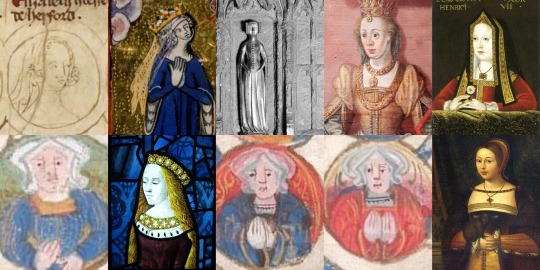
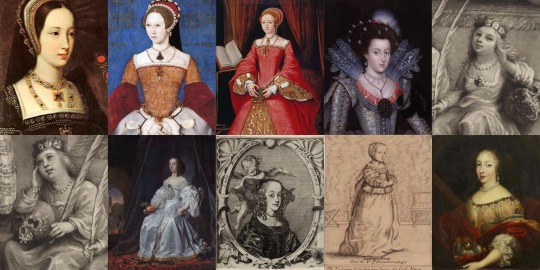
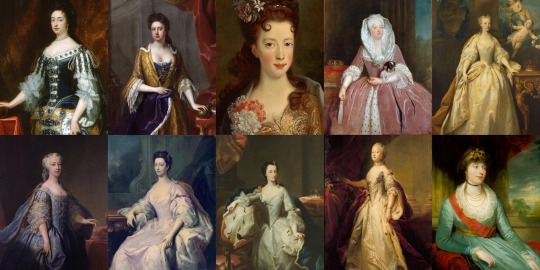
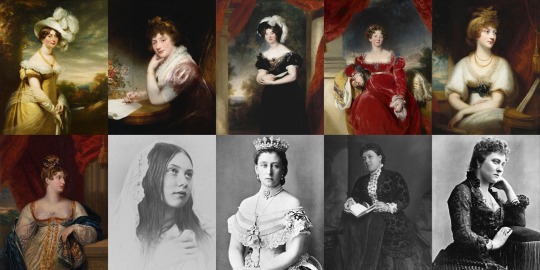

Every English Princess Ever
You’ve heard of Every Queen of England Ever, now I present to you another product that proves I have way too much time on my hands! If you notice any mistakes, please point them out to me kindly. I am sorry I do not know everything, but there is no reason to be rude. 😁
Æthelswith - Daughter of Æthelwulf and his first wife Osburh. She married King Burgred of Mercia in 853, making her the Queen of Mercia.
Æthelflæd - Daughter of Alfred the Great and Ealhswith. When her husband Æthelred, Lord of Mercians died in 911, she became Lady of the Mercians, and reigned for seven years.
Æthelgifu - Daughter of Alfred the Great and Ealhswith. When Alfred founded Shaftesbury Abbey in 890, he made her its first abbess.
Ælfthryth - Daughter of Alfred the Great and Ealhswith. Her marriage to Baldwin II, Count of Flanders made her Countess of Flanders.
Eadgifu - Daughter of Edward the Elder and his second wife Ælfflæd. She was Queen of West Francia by her marriage to Charles III.
Eadhild - Daughter of Edward the Elder and his second wife Ælfflæd. She married Hugh, Duke of the Franks in 937.
Eadgyth - Daughter of Edward the Elder and his second wife Ælfflæd. She married Otto in 930, who became Otto I, King of Germany in 936, also making her Queen of Germany.
Eadburh - Daughter of Edward the Elder and his third wife Eadgifu. She lived her life as a nun.
Godgifu - Daughter of Æthelred the Unready and his second wife Emma of Normandy. Her marriage to Eustace II, Count of Boulogne made her Countess of Boulogne.
Gunhilda - Daughter of Cnut the Great and his second wife Emma of Normandy. She became Queen of Germany when she married Henry III.
Gytha - Daughter of Harold II and Edith Swanneck. She was Princess of Rus from her marriage to Vladimir II Monomakh.
Adeliza - Daughter of William the Conqueror and Matilda of Flanders.
Cecilia - Daughter of William the Conqueror and Matilda of Flanders. She was entered into the Abbey of the Holy Trinity of Caen at a young age, and became Abbess in 1112.
Constance - Daughter of William the Conqueror and Matilda of Flanders. She became Duchess of Brittany when she married Alan IV, Duke of Brittany.
Adela - Daughter of William the Conqueror and Matilda of Flanders. She was Countess of Blois by her marriage to Stephen, Count of Blois, and was regent of Blois two times.
Empress Matilda - Daughter of Henry I and Matilda of Scotland. She became Holy Roman Empress in 1114, and acted as Queen of England from 1141 to 1148, but was disputed.
Marie I - Daughter of Stephen and Matilda I, Countess of Boulogne. When her brother William I, Count of Boulogne died childless in 1159, Marie succeeded him as the Countess of Boulogne.
Matilda - Daughter of Henry II and Eleanor of Aquitaine. She was Duchess of Saxony and Bavaria from her marriage to Henry the Lion.
Eleanor - Daughter of Henry II and Eleanor of Aquitaine. She became Queen of Castile and Toledo when she married Alfonso VIII.
Joan - Daughter of Henry II and Eleanor of Aquitaine. She was Queen of Sicily by her marriage to William II until his death in 1189, and became Countess of Toulouse when she married Raymond VI in 1196.
Joan - Daughter of John and Isabella of Angoulême. She was Queen of Scotland by her marriage to Alexander II.
Isabella - Daughter of John and Isabella of Angoulême. She was Holy Roman Empress and Queen of Sicily and Germany by her marriage to Frederick II.
Eleanor - Daughter of John and Isabella of Angoulême. She was Countess of Pembroke by her first marriage to William Marshal, 2nd Earl of Pembroke, and Countess of Leicester by her second marriage to Simon de Montfort, 6th Earl of Leicester.
Margaret - Daughter of Henry III and Eleanor of Provence. She was Queen of Scotland by her marriage to Alexander III.
Beatrice - Daughter of Henry III and Eleanor of Provence. (Her wikipedia says she was Countess of Richmond, which I’m not sure is true or not. Her husband was the Duke of Brittany, but it is possible she somehow inherited the title in her own right).
Katherine - Daughter of Henry III and Eleanor of Provence. She passed away at the age of three.
Eleanor - Daughter of Edward I and Eleanor of Castile. She was Countess of Bar by her marriage to Henry III, Count of Bar.
Joan of Acre - Daughter of Edward I and Eleanor of Castile. She was Countess of Hertford and Gloucester by her first marriage to Gilbert de Clare, 7th Earl of Gloucester and 6th Earl of Hertford.
Margaret - Daughter of Edward I and Eleanor of Castile. She was Duchess of Brabant, Lothier and Limburg by her marriage to John II.
Mary of Woodstock - Daughter of Edward I and Eleanor of Castile. She was a nun at Amesbury Priory.
Elizabeth of Rhuddlan - Daughter of Edward I and Eleanor of Castile. She was Countess of Holland by her first marriage to John I, and Countess of Hereford by her second marriage to Humphrey de Bohun, 4th Earl of Hereford.
Eleanor of Woodstock - Daughter of Edward II and Isabella of France. She was Duchess of Guelders by her marriage to Reginald II, and was regent of Guelders while her son was still young.
Joan of the Tower - Daughter of Edward II and Isabella of France. She got her name from being born in the Tower of London. Joan was Queen of Scotland by her marriage to David II.
Isabella - Daughter of Edward III and Philippa of Hainault. She was Countess of Bedford and Lady of Coucy by her marriage to Enguerrand VIII, and was made a Lady of the Garter in 1376.
Joan - Daughter of Edward III and Philippa of Hainault. She died during the Black Death at the age of fourteen.
Mary of Waltham - Daughter of Edward III and Philippa of Hainault. She was Duchess of Brittany by her marriage to John IV, Duke of Brittany, and was made a Lady of the Garter in 1378. She died young at the age of sixteen.
Margaret of Windsor - Daughter of Edward III and Philippa of Hainault. She was Countess of Pembroke by her marriage to John Hastings, 2nd Earl of Pembroke. Margaret died young at the age of fifteen.
Blanche of Lancaster - Daughter of Henry IV and Mary de Bohun. She was Electress Palatine by her marriage to Louis III, Electress Palatine.
Philippa of Lancaster - Daughter of Henry IV and Mary de Bohun. She was Queen of Denmark, Sweden and Norway by her marriage to Eric III, VIII & XIII.
Elizabeth of York - Daughter of Edward IV and Elizabeth Woodville. She was Queen of England by her marriage to Henry VII.
Mary of York - Daughter of Edward IV and Elizabeth Woodville. She died at the age of fourteen.
Cecily of York - Daughter of Edward IV and Elizabeth Woodville. She was First Lady of the Bedchamber to her sister, Elizabeth of York, from 1485 to 1487. Cecily was Viscountess Welles by her marriage to John Welles, 1st Viscount Welles.
Margaret of York - Daughter of Edward IV and Elizabeth Woodville. She died at just eight months old.
Anne of York - Daughter of Edward IV and Elizabeth Woodville. She was First Lady of the Bedchamber to her sister, Elizabeth of York, from 1487 to 1494.
Catherine of York - Daughter of Edward IV and Elizabeth Woodville. She was Countess of Devon by her marriage to William Courtenay, 1st Earl of Devon.
Bridget of York - Daughter of Edward IV and Elizabeth Woodville. She was a nun at Dartford Priory.
Margaret Tudor - Daughter of Henry VII and Elizabeth of York. She was Queen of Scotland by her marriage to James IV of Scotland.
Elizabeth Tudor - Daughter of Henry VII and Elizabeth of York. She died at the age of three.
Mary Tudor - Daughter of Henry VII and Elizabeth of York. She was Queen of France by her first marriage to Louis XII of France, and Duchess of Suffolk by her second marriage to Charles Brandon, 1st Duke of Suffolk.
Mary I - Daughter of Henry VIII and Catherine of Aragon. She was Queen of England from 1553 to 1558, and Queen of Spain by her marriage to Philip II of Spain.
Elizabeth I - Daughter of Henry VIII and Anne Boleyn. She was Queen of England from 1558 to 1603.
Elizabeth Stuart - Daughter of James VI & I and Anne of Denmark. She was Electress Palatine and Queen of Bohemia by her marriage to Frederick V.
Margaret Stuart - Daughter of James VI & I and Anne of Denmark. She died at the age of one year old.
Mary Stuart - Daughter of James VI & I and Anne of Denmark. She died at the age of two years old.
Sophia Stuart - Daughter of James VI & I and Anne of Denmark. She lived for just one day.
Mary - Daughter of Charles I and Henrietta Maria. She was Princess of Orange and Countess of Nassau by her marriage to William II, Prince of Orange.
Elizabeth Stuart - Daughter of Charles I and Henrietta Maria. She died at the age of fourteen.
Anne Stuart - Daughter of Charles I and Henrietta Maria. She died at the age of three.
Henrietta - Daughter of Charles I and Henrietta Maria. She was Duchess of Orléans by her marriage to Philippe I, Duke of Orléans.
Mary II - Daughter of James II & VII and Anne Hyde. She was Queen of England from 1689 to 1694.
Anne - Daughter of James II & VII and Anne Hyde. She was Queen of England and Great Britain from 1702 to 1714.
Louisa Maria Stuart - Daughter of James II & VII and Mary of Modena. She died at the age of nineteen.
Sophia Dorothea of Hanover - Daughter of George I and Sophia Dorothea of Celle. She was Queen of Prussia and Electress Brandenburg by her marriage to Frederick William I of Prussia.
Anne - Daughter of George II and Caroline of Ansbach. She was Princess of Orange by her marriage to William IV, Prince of Orange.
Amelia of Great Britain - Daughter of George II and Caroline of Ansbach.
Caroline Elizabeth of Great Britain - Daughter of George II and Caroline of Ansbach.
Mary of Great Britain - Daughter of George II and Caroline of Ansbach. She was Landgravine of Hesse-Kassel by her marriage to Frederick II, Landgrave of Hesse-Kassel.
Louise of Great Britain - Daughter of George II and Caroline of Ansbach. She was Queen of Denmark and Norway by her marriage to Frederick V of Denmark.
Charlotte - Daughter of George III and Charlotte of Mecklenburg-Strelitz. She was Duchess, Electress and Queen of Württemberg by her marriage to Frederick I of Württemberg.
Augusta Sophia - Daughter of George III and Charlotte of Mecklenburg-Strelitz.
Elizabeth - Daughter of George III and Charlotte of Mecklenburg-Strelitz. She was Landgravine of Hesse-Homburg by her marriage to Frederick VI, Landgrave of Hesse-Homburg.
Mary - Daughter of George III and Charlotte of Mecklenburg-Strelitz. She was Duchess of Gloucester and Edinburgh by her marriage to Prince William Frederick, Duke of Gloucester and Edinburgh.
Sophia - Daughter of George III and Charlotte of Mecklenburg-Strelitz.
Amelia - Daughter of George III and Charlotte of Mecklenburg-Strelitz.
Charlotte of Wales - Daughter of George IV and Caroline of Brunswick. She was their only child, and died before both of them.
Charlotte Augusta Louisa of Clarence - Daughter of William IV and Adelaide of Saxe-Meiningen. She died shortly after birth.
Elizabeth Georgiana Adelaide of Clarence - Daughter of William IV and Adelaide of Saxe-Meiningen. She died shortly after birth.
Victoria - Daughter of Queen Victoria and Prince Albert. She was German Empress and Queen of Prussia by her marriage to Frederick III, German Emperor.
Alice - Daughter of Queen Victoria and Prince Albert. She was Grand Duchess of Hesse and Rhine by her marriage to Louis IV, Grand Duke of Hesse.
Helena - Daughter of Queen Victoria and Prince Albert. She was Princess of Schleswig-Holstein by her marriage to Prince Christian of Schleswig-Holstein.
Louise - Daughter of Queen Victoria and Prince Albert. She was Duchess of Argyll and Viceregal of Canada by her marriage to John Campbell, 9th Duke of Argyll.
Beatrice - Daughter of Queen Victoria and Prince Albert. She was Princess of Battenberg by her marriage to Prince Henry of Battenberg.
Louise of Wales - Daughter of Edward VII and Alexandra of Denmark. She was Duchess of Fife by her marriage to Alexander Duff, 1st Duke of Fife.
Victoria of Wales - Daughter of Edward VII and Alexandra of Denmark.
Maud of Wales - Daughter of Edward VII and Alexandra of Denmark. She was Queen of Norway by her marriage to Haakon VII of Norway.
Mary of York - Daughter of George V and Mary of Teck. She was Countess of Harewood by her marriage to Henry Lascelles, 6th Earl of Harewood.
Elizabeth II - Daughter of George VI and Elizabeth Bowes-Lyon. She is Queen of the UK from 1952 to present.
Margaret Rose of York - Daughter of George VI and Elizabeth Bowes-Lyon. She was Countess of Snowdon.
Anne of Edinburgh - Daughter of Elizabeth II and Prince Philip.
#british history#historical women#empress matilda#elizabeth of york#margaret tudor#mary i#elizabeth i#british royal family
160 notes
·
View notes
Photo

Day Of The Wedding (Part 3) But Charlotte did not forget her beloved Margaret. 'To show you how constantly you occupy my thoughts,' she wrote two days later, 'my last word was with Lieven to intreat her to give you a faithful account, & to my maid just as I drove off to go & tell you how I looked & was ...'
#augusta of the united kingdom#carlton house#charles manners-sutton archbishop of canterbury#charlotte of mecklenburg-strelitz (queen of the united kingdom)#edward duke of kent#elizabeth of the united kingdom(landgravine of hesse-homburg)#frederica charlotte of prussia duchess of york and albany#frederick duke of york#george IV (prince of wales and prince regent)#mary duchess of gloucester and edinburgh#mrs alicia campbell#oatlands#prince leopold of saxe-coburg-gotha (later king of the belgians)#princess charlotte of wales#princess dorothea von lieven née benckendorff#prinny&039;s daughter: a biography of princess charlotte of wales#sophia of the united kingdom#the hon.margaret mercer elphinstone#thea holme#william howley bishop of london#william IV king of the united kingdom (duke of clarence)
0 notes
Text
Magazine "Ueber Land und Meer" illustration depicting young German unmarried Princesses in 1895.
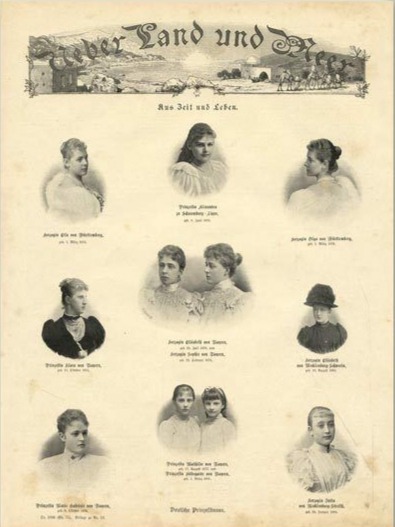
Back row: Duchess Elsa of Württemberg, Princess Alexandra of Schaumburg-Lippe and Duchess Olga of Württemberg.
Back row: Duchess Elsa of Württemberg, Princess Alexandra of Schaumburg-Lippe and Duchess Olga of Württemberg.
Middle row: Princess Clara of Bavaria, Duchesses Sophia Adelheid and Elisabeth in Bavaria, and Duchess Elisabeth Alexandrine of Mecklenburg-Schwerin.
Front row: Duchess Marie Gabrielle in Bavaria, Princesses Mathilde and Hildegarde of Bavaria and Duchess Jutta of Mecklenburg-Strelitz.
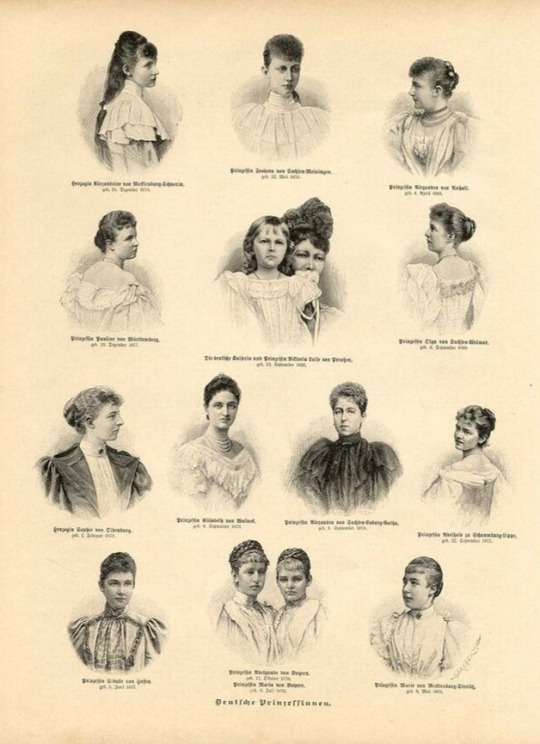
Back row: Duchess Alexandrine of Mecklenburg-Schwerin, Princess Feodora of Saxe-Meiningen and Princess Alexandra of Anhalt.
Middle row (1) Princess Pauline of Württemberg, German Empress Augusta Victoria with her daughter, Princess Victoria Louise of Prussia and Princess Olga of Saxe-Weimar-Eisenach.
Middle row (2): Duchess Sophia Charlotte of Oldenburg, Princess Elisabeth of Waldeck and Pyrmont, Princess Alexandra of Saxe-Coburg and Gotha and Princess Adelaide of Schaumburg-Lippe.
Front row: Princess Sybille Marguerite of Hesse, Princesses Adelgunde and Maria Ludwiga of Bavaria, and Duchess Marie of Mecklenburg-Strelitz.
#duchess olga of württemberg#duchess elsa of württemberg#duchess jutta of mecklenburg-strelitz#duchess marie of mecklenburg-strelitz#duchess alexandrine of mecklenburg-strelitz#duchess elisabeth alexandrine of mecklenburg-strelitz#duchess sophie adelheid in bavaria#duchess elisabeth in bavaria#duchess marie gabrielle in bavaria#princess adelgunde of bavaria#princess maria ludwiga of bavaria#princess clara of bavaria#princess mathilde of bavaria#princess hildegarde of bavaria#princess adelaide of schaumburg-lippe#princess alexandra of schaumburg-lippe#princess feodora of saxe-meiningen#princess olga of saxe-weimar-eisenach#princess victoria louise of prussia#princess alexandra of saxe-coburg and gotha#princess sybille marguerite of hesse#princess elisabeth of waldeck and pyrmont#duchess sophia charlotte of oldenburg#princess pauline of württemberg#german royalty#german royal#1895#1890s#german empress augusta victoria
37 notes
·
View notes
Text

Queen Charlotte
Artist: Thomas Gainsborough (British, 1727–1788)
Date: This is a replica by Gainsborough of a portrait of the queen (Royal Collection) which he painted at Windsor Castle in September 1782.
Medium: Oil on Canvas
Collection: Metropolitan Museum, New York City, NY, United States
Charlotte of Mecklenburg-Strelitz
Charlotte of Mecklenburg-Strelitz (Sophia Charlotte; 19 May 1744 – 17 November 1818) was Queen of Great Britain and Ireland as the wife of King George III from their marriage on 8 September 1761 until her death in 1818. The Acts of Union 1800 unified Great Britain and Ireland into the United Kingdom of Great Britain and Ireland. As George's wife, she was also Electress of Hanover until becoming Queen of Hanover on 12 October 1814. Charlotte was Britain's longest-serving queen consort, serving for 57 years and 70 days.
#portrait#queen charlotte#thomas gainsborough#oil on canvas#british artist#british monarch#british history#european art#female#head piece#costume#necklace#british monarchy#18th century painting
15 notes
·
View notes